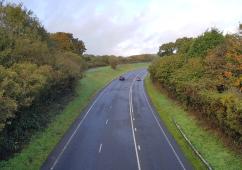Live Labs 2 blog - an update on the Wessex project
Celebrating successes at the halfway point for the Wessex Live Labs 2 project
This month our Live Labs 2 blog comes from Mike O’Dowd-Jones lead officer for the Wessex Partnership: Net Zero Corridors live lab and Service Director of Infrastructure and Transport for Somerset Council. Mike explores the latest information on the net zero corridors project.
Benefits in real terms
As the Live Labs 2 Wessex project passes the halfway mark, this is a suitable time to reflect on some highlights and achievements of the project so far. Working with our core team and partners, we’ve celebrated both big and incremental achievements.
The project’s focus is carbon reduction. From the start, the Wessex team has sought to include carbon in decision making for local highways. We’ve built tools and methods for carbon analysis, carbon budgeting and future planning, whilst exploring Doughnut Economics. Now, as the demonstration activity increases and we begin using these tools in the real world, we’re starting to see the work yield results and the benefits are becoming visible in real terms.
Demonstrator corridors
Our demonstration projects continue to progress. In Cornwall, we’ve finished activities on the Madron corridor. The final piece of work in December 2022 was to create a so-called ‘virtual footway’ using a skid-resistant coating made from a bio-resin derived from vegetable oil, the first time this has been used in the UK. As well as bio-resin production being much less carbon intensive, we also explored the suitability of using local aggregates to reduce the carbon footprint even further. We will share the knowledge we have gained with the sector once the testing is complete.
In Hampshire, trials on the A30 have used equipment fuelled by a mix of hydrogen and vegetable oil, to reduce the tailpipe carbon emissions from machinery carrying out roadworks. Trials of a new asphalt, which is laid at lower temperature and also replaces some of the bitumen with a naturally-sourced alternative, also show how the embodied carbon of the materials we use can be reduced in practice.
Hampshire County Council have also taken advantage of the cold weather to commence the trial of an electric gritter which we are using on one of our gritting routes to show that these vital services can be delivered just as effectively when powered by electricity. However, part of the trial will be to learn about any changes to the operations within the depot or out on the roads when moving away from the traditional diesel gritting fleet. Please see more here: https://youtu.be/zLNDDC-tzkM?si=qPU8tPnCVpaO6RoU
And in Somerset as we prepare for the ‘live’ trials starting in 2025, we have been learning from councils within the Wessex partnership and wider Live Labs 2 cohort. This includes the Greenprint project, where we were onsite to observe the processing of South Gloucestershire’s grass cuttings at a facility operated in Somerset.
‘Doughnut Economics’
Our workstream on Doughnut Economics aimed to apply this model to local highways. The goal is to balance environmental and social needs alongside decarbonisation. This is harder for highways than for other sectors, but we’ve created a toolkit, guidance, and resources to help.
The next step is testing and improving this method in different settings. This toolkit is the first of its kind for highways decision-makers and can be used for everything from entire services to individual projects.
Our first test was with Somerset’s Winter Service and Emergency Plan, working with our colleagues at Kier and the council. The toolkit also considers operational team needs, applying the same principles to their work.
Expanding the approach
As the workstreams have progressed, connections between them have become clearer. For example, the Doughnut toolkit’s scorecard links with the Future Highways Research Group’s Carbon Analyser tool. This helps decision-makers combine social, ecological, and robust carbon data. We’ve also shared this work widely, including at Global Doughnut Day and COP29.
So far we’ve calculated carbon footprints for three councils and one road corridor to use as a baseline for interventions. These support work that the University of Exeter are doing to develop a new Carbon Budgeting method specifically for roads; we’re now starting to explore how councils can use this in practice.
They’re also helping us overcome barriers to change through their research on Positive Tipping Points. For instance, we’re looking at ways to link this work to help find ways to reduce inspection-related travel, first within Somerset Council.
Next Steps
We’ll continue strengthening links between our projects and maintaining momentum. The Doughnut toolkit will be tested across all Wessex authorities at different levels, from contracts to specific maintenance tasks.
We also plan to evaluate recommendations from the lean travel exercise and improve engagement materials. Carbon analysis will expand to focus on specific corridors, showing paths to net zero beyond Live Labs.
Looking Ahead
In Year 3, we’ll demonstrate activities in various corridor locations, including:
- Cornwall: A391 near St Austell
- Hampshire: A336 (Cadnam to Netley Marsh) and A32 (Denmead to Droxford)
- Somerset: Galmington Road (Taunton), A38 (near Devon border), and B3139 (Wells to Highbridge)
The goal is to show how these trials can be scaled up and applied across the sector, especially the carbon budgeting and Doughnut tools. We’ll also continue focusing on behaviour change, which remains the golden thread throughout Live Labs 2; and key to the success of this project and the programme as a whole.

